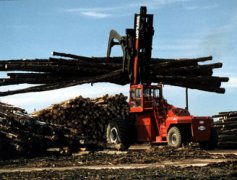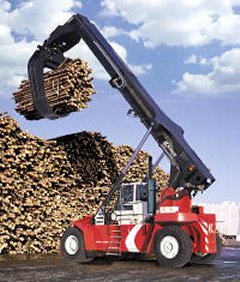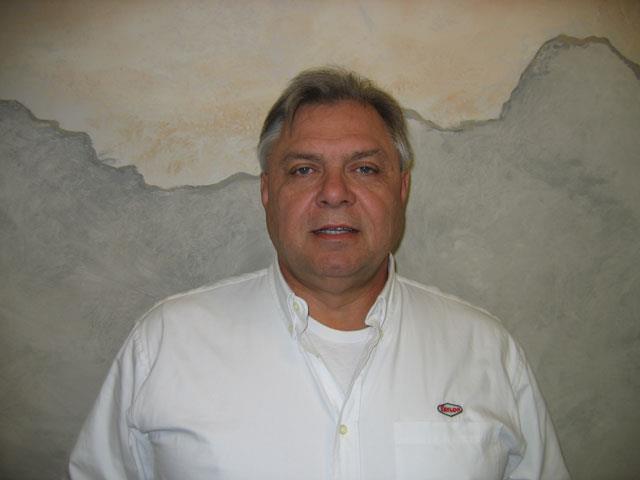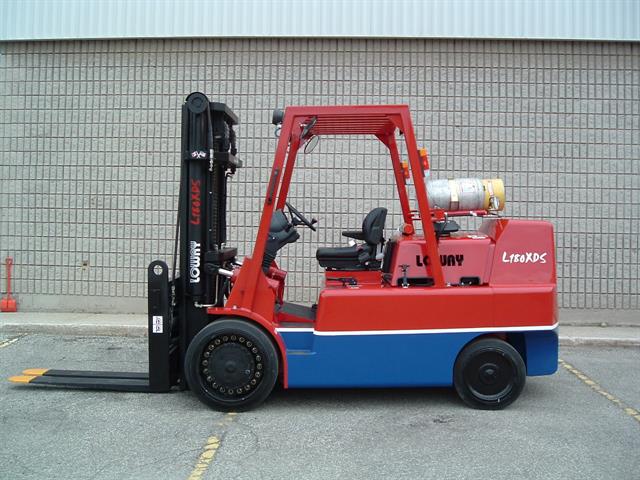 A Taylor forklift in Canada. |
Canada, populated by about 30 million people, is the world's second largest country by land area, after Russia. Located north of the world's leading forklift market, Canada is, according to its national statistical agency, the US's largest trading partner. Statistics Canada said the 2005 US-Canada trade relationship was more than CAD1.7 billion (USD1.489 billion) in trade a day. In Canada, 81 per cent of exports and 67 per cent of imports were with the US. According to US Census Bureau statistics for 2005, US exports to Canada were 23 per cent and imports 17 per cent. That was more than US trade with all EU countries combined.
Val Wright spoke to
Forkliftaction.com News reporter
Christine Liew about the forklift market in Canada last week. Wright, sales manager with Canadian heavy equipment and Hyster forklift distributor Wajax Industries, has 36 years' experience in the materials handling industry. He represented big forklift specialist Taylor Machine Works for 18 years and is now Wajax's Hyster sales manager for British Columbia.
Wright said that, apart from Japanese players Toyota and Nissan, North American forklift brands were dominant in the former British colony.
"Toyota is number one by market share. For classes 1, 2 and 3, Raymond and Crown are leaders.
 Kalmar forklift. |
"In Canada, Hyster is the only manufacturer that builds all the way from pallet trucks to container handlers. Market share is evenly split between Nissan, Hyster, Yale, Mitsubishi and Cat Lift Trucks. Other participants include Doosan Infracore (Daewoo), TCM and Taylor. On a local west coast scene, Kalmar has done very well."
Wright said the US-based Industrial Truck Association (ITA) estimated Canada consumed 18,000 forklifts in 2005. In contrast, the world's biggest forklift market, the US, consumed 194,475 units. ITA represents forklift manufacturers and their suppliers in the US, Canada and Mexico.
Japanese manufacturers had the "lion's share", with more than 40 per cent of the Canadian forklift market. They arrived in the 1970s and 1980s and had time to cultivate the market, Wright said.
Hyster had been in Canada since the 1930s. In 1967 Hyster partnered with Wajax to represent the brand throughout Canada.
Asked how Japanese manufacturers, like Toyota, managed to surpass Hyster, which had been present in Canada longer, Wright said: "When Japanese manufacturers entered the North American market, they came with unheard-of low prices. Gradually, as they gained recognition, they elevated prices, but not for many years."
Geographical proximity can be credited for the popularity of US forklifts in Canada. However, the two countries also share similar manufacturing standards, like the ANSI standards in the US and WCB in Canada for explosion-proof conversion. Canada also uses imperial measurements for pallet sizes and forklift specifications.
"Speed, distance and temperature are commonly expressed in metric [in Canada] but, in materials handling, we haven't done that. Probably because the US materials handling market is so big, they haven't done that and we have followed suit," Wright said.
Forklift specification sheets in Canada contain metric and imperial measurements.
"But, when we discuss with customers, it's all in imperial," Wright said. Although there was a trend to express container weights in metric tonnes.
The bulk of Canada's manufacturing sector is in southern Ontario, but Canada's 10 provinces and three territories are spread across nearly 10 million square kilometres of land.
Logging is a key sector in Canada's economy and an industry where big forklifts, like Kalmar and Taylor machines, are used. Canada's timber productive forest land comprises 25 per cent of Canada's total land area and stretches from the Yukon territory on the west to Canada's most easterly province, Newfoundland & Labrador, which is said to be almost 1.75 times the size of Great Britain.
Taylor sales representative Lou Proietti said the size of the country posed a challenge in servicing forklifts. Taylor dealers were "strategically located" throughout Canada and typically had several locations to service customers.
 Taylor sales representative Lou Proietti. |
"Customers have accepted the fact that, if they work in remote areas, good equipment and preventive maintenance are keys to uptime.
"Some jobs are in the far reaches of our borders and hence require technicians to be very well trained in all aspects of our equipment.
"It is important to fix it right the first time," he said.
Wright agreed it was hard to service accounts in Canada. He said Wajax Industries, a public company established in Canada in 1858, had branches all over Canada. Wajax has 2,600 employees and annual sales exceeding CAD1.1 billion (USD963.7 million).
"It's not unusual to travel four hours to make a sales call because of the demanding geographical distance. For smaller dealerships, it's difficult to go to the end user. The headquarters may be in Vancouver but the application or facility could be 400 miles to the north."
Wright said Hyster's big forklifts (17,000lb/7,711.1kg capacity and up), built in Njmegen, in the Netherlands, had responded to the needs of lumber handling.
"[These forklifts] have different types of forks specific to the lumber packages handled, side shift under load with fork positioning is popular. They have special swivel seats for operator comfort when reverse driving, overhead visibility for stacking lumber and packages to higher elevations, special mud flaps to protect lumber from spray, and extra lights for working late night shifts," he said.
Canada's harsh winters and hot summers mean forklifts have to work in temperatures ranging from -32 deg Celcius to 32 deg Celcius.
 Canadian forklift Lowry. |
Proietti said: "Typically our applications are similar to the US. Some become more of a challenge in winter because of inclement weather but most do not differ from the northern states of the US.
"Taylor offers all the necessary devices required to operate in the coldest weather Canada has and still operate in the extreme heat of summer, which can get to the high 90s (Farenheit) during summer.
"We also offer a line of big wheel trucks that can be used in extreme snow conditions," he said.
In 2004, nearly four million TEUs were handled in Canada's six mainland ports - Port of Vancouver, Port of Montreal, Port of Halifax, Fraser River Port, Port of Saint John and Port of Toronto.
"Our intermodal and container terminals offer some challenges because our transport laws differ and Canadian truckers are able carry heavier weights on our highways. Equipment capacities must be higher at the point of entry and in the terminals," Proietti said.
Wright said product support was essential because many ports and off-dock facilities in Canada now ran reach stackers, top pick machines and empty container handlers on the same facility.
Proietti and Wright believe North American brands have an advantage over European brands in Canada, because of geographical proximity.
"It's more difficult for European manufacturers in the Canadian market because the forklifts are still perceived to be imported from far away. There's a perceived parts availability problem," Wright said.
"Linde and Jungheinrich are trying to increase market share but we in North America have not seen that to a big extent yet," he said.
However, Wright conceded European manufacturers could build on their established reputation in "design, reliability and longevity"
"Once introduced to a particular application, the European machines tend to gain acceptance."
Proietti said Taylor forklifts were competent in "strength, durability, resale value and flexibility on the job".
"[Taylor] builds its trucks with parts made in North America, allowing us better, quicker access when required by the customer. We have factory-trained technicians at our facilities and an educated parts and service staff [who] solve customers and dealers' problems as quickly as possible."